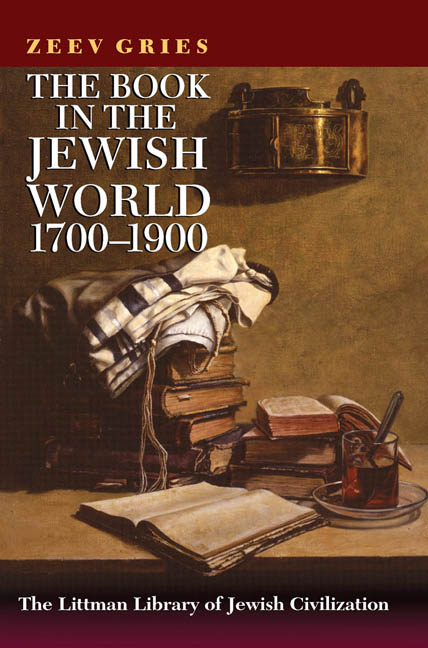Book contents
- Frontmatter
- Dedication
- Preface to the English Edition
- Contents
- List of Illustrations
- Note on Bibliographical Conventions and Transliteration
- Introduction
- PART I THE AWAKENING OF THE NASCENT INTELLIGENTSIA
- 1 Expanding Horizons
- 2 On Reading and Readers
- 3 Elite Literature: Halakhic Works and Textual Commentaries
- 4 Ethical Literature in Hebrew and Yiddish
- 5 On Libraries Private and Public
- 6 Kabbalistic Literature and its Role in Hasidism
- 7 Literature for Women and Children Only, or for Everyone?
- PART II THE BOOK: GUARDIAN OF THE SACRED OR HERALD OF SECULARIZATION?
- Afterword: The Revolution in the World of Hebrew Books at the Start of the Twentieth Century
- Appendix: The Young Abraham Ya'ari
- Bibliography
- Index of Books and Periodicals
- Index of Places
- Index of People
- Index of Subjects
6 - Kabbalistic Literature and its Role in Hasidism
from PART I - THE AWAKENING OF THE NASCENT INTELLIGENTSIA
- Frontmatter
- Dedication
- Preface to the English Edition
- Contents
- List of Illustrations
- Note on Bibliographical Conventions and Transliteration
- Introduction
- PART I THE AWAKENING OF THE NASCENT INTELLIGENTSIA
- 1 Expanding Horizons
- 2 On Reading and Readers
- 3 Elite Literature: Halakhic Works and Textual Commentaries
- 4 Ethical Literature in Hebrew and Yiddish
- 5 On Libraries Private and Public
- 6 Kabbalistic Literature and its Role in Hasidism
- 7 Literature for Women and Children Only, or for Everyone?
- PART II THE BOOK: GUARDIAN OF THE SACRED OR HERALD OF SECULARIZATION?
- Afterword: The Revolution in the World of Hebrew Books at the Start of the Twentieth Century
- Appendix: The Young Abraham Ya'ari
- Bibliography
- Index of Books and Periodicals
- Index of Places
- Index of People
- Index of Subjects
Summary
KABBALAH is the form of mysticism that developed among the Jews at the end of the twelfth century.While long consigned to the margins of scholarship as a strange phenomenon originating in hallucinations and culminating in illusions, as a result of the pioneering scholarship of Gershom Scholem it has come to be recognized as an integral part of Judaism which requires thorough study if we are to understand its place in Jewish culture.
So far, however, little scholarly attention has been given to the history of kabbalistic works in manuscript and print, their diffusion, and their public reception. The study of such factors could be highly significant in determining the role played by kabbalah in formulating the Jewish world-view and encouraging the longing for messianic redemption, as well as helping us understand the rituals and customs known to have been an important factor in stimulating the spiritual dimension of Judaism, which is essentially a religion of law. It would likewise help determine the role that kabbalah has played in shaping Jewish history, both through the spiritual leaders who adopted its tenets and through its influence on the general public. An examination of the diffusion and reception of different types of kabbalistic books and of the testimonies of those who read them, for example, could help us to evaluate the status and motive power of kabbalah in Shabateanism (the mass messianic movement of the seventeenth century), or in the hasidic movement established by Israel Ba'al Shem Tov in the eighteenth century. It may enable us, too, to flesh out the figure of the charismatic leader, who with one hand clung to halakhah, studying and observing it just like his ancestors and teachers, while in the other he clasped kabbalah, with, for the most part, no obvious tension between the two. Finally, such a study could provide a definitive answer as to whether kabbalistic works, by offering alternative approaches to Judaism, paved the way to the changes in Jewish consciousness that allowed the Haskalah and the spirit of modern times to take root, or whether they impeded the move towards modernity by enveloping Jewish consciousness in myths and superstitions, the forces of evil, demons, magical charms, and amulets.
- Type
- Chapter
- Information
- The Book in the Jewish World, 1700–1900 , pp. 69 - 90Publisher: Liverpool University PressPrint publication year: 2007

